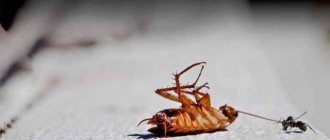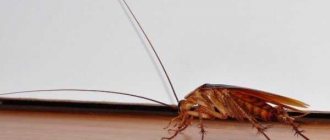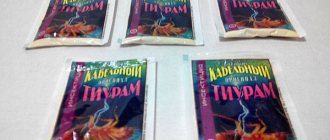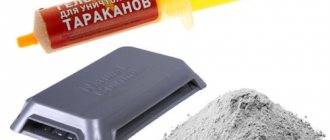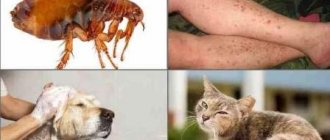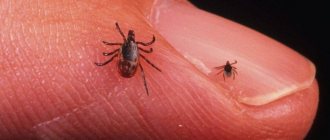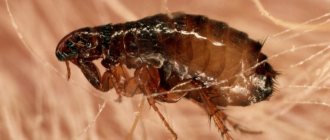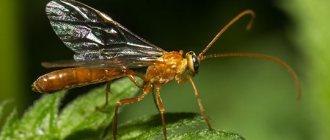Boric acid is a substance that is used in medicine, cosmetology and as an insecticide to kill insects. For treatment, it is used externally in pure or diluted form. If a poison based on this substance is accidentally ingested, which often happens with domestic animals, boric acid poisoning occurs. If you suspect that a toxin has entered the gastrointestinal tract, you should immediately consult a doctor or veterinarian.
Safety precautions when using boric acid poisons
Despite the fact that the drug is called “acid,” it has nothing in common with the usual understanding of this word.
It is harmless to the skin and does not leave any burns. The chemical is not considered particularly dangerous for children or pets. Previously, it was even used as an antiseptic. But it often caused allergies, and it was soon replaced by more suitable means.
If we compare it with other poisons for baiting cockroaches, we should also say about its safety for the human body. However, contact with boric acid is strictly contraindicated for children under three years of age. If it happens that a pet accidentally eats the bait, then nothing fatal will happen to it, but it is better not to allow this to happen.
Pregnant and lactating women, people with kidney failure and inflammatory skin diseases are also better off not interacting with this drug.
If the incident cannot be avoided, the person may experience symptoms such as nausea, vomiting, skin rashes and headaches.
When choosing a recipe for cockroaches with boric acid, what should you consider?
Any cockroach remedy with boric acid you choose will be 100% safe for animals in the house and children. But there is one “But”. The antiseptic substance has an allergic effect. More precisely, its components can cause skin allergies upon contact in children and people with sensitive skin. That is why cockroach poison with boric acid and egg, the recipe for which has been known for several 10 years, is the safest way to poison insects. If you have sensitive skin, wear gloves and work in them.
Powder and boron balls against cockroaches do not cause:
- Skin irritation;
- Burns (even sensitive skin does not suffer);
- Irritation of the mucous membranes of the lungs and oral cavity;
- Poisoning in animals and people.
Cheap cockroach poison with boric acid - 100% safe. Do not use pure powder in the house if there are children or people with allergies.
Poisoning in animals
Boric acid intoxication is often diagnosed in animals. The main cause is eating insect poison. Symptoms fully appear a couple of days after poisoning, but the first signs are noted within an hour.
Signs:
- Digestive disorder
- Nausea, vomiting,
- Blood in stool (liquid)
- In dogs, body temperature drops to 36 degrees,
- Cats start drinking a lot
- Animals have a red rash on the skin,
- The animal becomes lethargic, apathetic, and has no appetite.
Animals often experience convulsive muscle contractions. If signs of overdose are detected, you should quickly contact a veterinarian. In small animals, poisoning is more intense than in adults.
The critical dosage is from seven to fifteen grams of the substance per ten kilograms of weight.
First aid for such poisoning is provided by a specialist. Treatment includes a series of actions aimed at restoring the animal's normal state.
Actions:
- Cleansing the stomach of toxin using a probe,
- Carrying out forced diuresis,
- Restoration of water-salt and acid-base balance.
The pet's health will be restored quite quickly if assistance is provided correctly and quickly.
What is boric acid?
In its pure form, boric acid is a white crystalline powder. In medicine it is used in the form of a weak alcohol or aqueous solution.
The antiseptic properties of boric acid were discovered by the French chemist Jean Baptiste Dumas. After that, it began to be actively used in medicine instead of the previously used smelly carbolic acid: boric acid did not leave marks on the sheets in hospital wards and did not smell. However, later more effective antiseptics were discovered. Compare: the usual concentration of boric acid for antimicrobial treatment is 2 or 3%, and, for example, chlorhexidine - 0.05%. Therefore, recently boric acid is more often used in home medicine cabinets than in medical institutions.
The substance has a third class of hazard, therefore it must be stored in special packaging, out of reach. Boric acid is used:
- In medicine to relieve inflammation of the skin, eye sclera, and ear canal.
- As an antiseptic for healing wounds and bedsores; in low concentrations it can be used as a solution for contact lenses.
- As a poison against insects indoors.
- In agriculture as a fertilizer to accelerate plant growth and to kill pests.
- In industry in glass production (borosilicate glass is resistant to sudden temperature changes), in the production of enamels, some detergents and cosmetics.
Description
Boric acid is a white chemical powder. When dissolved in alcohol, a clear liquid is formed. Has a number of useful effects when used.
Properties:
- Anti-inflammatory,
- Antiseptic,
- Relieves fungal diseases
- Dries out the skin,
- Helps get rid of lice.
Boric acid is included in many external medicines. The scope of application of the drug is quite wide.
Where used:
- A solution with a concentration of two percent is used to wash the eyes.
- Three percent liquid is used for therapeutic compresses for skin diseases.
- An alcohol solution is often used for inflammatory processes of the hearing aid.
- Boric ointment is used as a medicine for head lice.
- The most common use in everyday life is against harmful insects. Boric acid powder is mixed with boiled yolk. The finished product in the form of balls is laid out in places where pests accumulate. However, you need to carefully monitor that such a “delicacy” is not eaten by domestic cats or dogs.
- Boric acid is present in lens solutions and is used to create soap.
- In crop production, the substance is used as part of fertilizers; it helps increase productivity and reduces the risk of rotting.
The use of a chemical product requires care and caution to avoid poisoning.
Boric acid and its characteristics
Before using this drug to kill pests, you need to understand what it is. Boric acid is a colorless powder, somewhat similar to flakes. The powder can hardly be dissolved in water, and it is absolutely tasteless and odorless. Relative safety allows people to actively use it for their needs.
Acid is sold in any pharmacy, packaged in 10 gram bags. Due to the lack of odor, the drug can be discreetly placed in the bait without scaring off the Prussians. This is the method of pest control.
Let us next consider what recipes exist with boric acid for cockroaches.
Consequences and prevention
Intoxication with boric acid can lead to the development of negative consequences.
We recommend: Why nitrogen is dangerous, nitrogen poisoning - symptoms and signs
What happens:
- Inflammatory processes in the liver and kidneys,
- Malfunctions of the cardiac system,
- Development of a comatose state,
- Death.
A favorable prognosis does not guarantee the absence of pathological processes in the kidneys. You can avoid poisoning by following simple prevention measures.
Rules:
- Do not store the substance in accessible places,
- Be careful when using a chemical compound
- It is not recommended to use the product to control insects in a home with animals.
- The substance should not be used for self-medication.
An overdose of boric acid can give a person a lot of unpleasant sensations. Without help, death is possible. If signs appear, you need to quickly contact a medical facility.
Boric acid, potatoes and yolk
A very effective remedy for cockroaches. Potatoes, yolk, boric acid - its main components - simple ingredients, found in every home.
We suggest you familiarize yourself with How to remove paint from clothes
First you need to boil one egg and potatoes. Then peel the finished products and grind them into puree. Equal proportions of boric acid and yolk should be observed. Mix the resulting mass with a tablespoon of boric acid, and then form into balls. Place the finished bait in the corners and do not forget about a dry surface throughout the kitchen.
How to poison cockroaches with boric acid and eggs?
Insects love the “dump” and dirty corners, as well as moisture and darkness. This means that the apartment or house needs to be prepared for the grass of the Prussians. Before using yolk and boric acid against cockroaches, you must:
- Wash the apartment behind the furniture, under the baseboards, thoroughly vacuum the parquet floors, cracks, and furniture. Egg yolk with boric acid will not help against cockroaches if the insects have a choice in food.
- Prepare in the evening (right before the laying out procedure) balls with boric acid and egg against cockroaches, the recipe for which should be chosen in advance and all the ingredients prepared.
- Wipe dry taps, tiles in the kitchen and bathroom.
- Close all taps tightly. The dripping ones need to be fixed. Remember that cockroaches love moisture - boric acid in recipes will simply lose its concentration if it is diluted with water.
- Hide all wet hygiene and cleaning products overnight.
- Moving all indoor flowers to another room is the best source of moisture. If liquid boric acid is used against cockroaches, pay special attention to its concentration. Do not omit the dilution, otherwise there will be no effect.
Despite the fact that the most effective remedy for cockroaches is boric acid, you will not be able to get rid of cockroaches unless you follow all the rules of baiting. Poisonous treats are placed in all dark places where garbage has been swept away during cleaning. And also use boron powder against cockroaches in other rooms to prevent insects from escaping from the kitchen or bathroom into the bedroom or living room.
The bullying process is not quick. Decomposed boric acid cockroach poison should be removed no earlier than after 1.5-2 months. And in apartments on the first and last floors it should be used constantly. It happens that Prussians run away from their neighbors. Then it makes sense to tell them how to get rid of cockroaches with boric acid and recommend a recipe. But also take preventive measures yourself. By applying comprehensive measures, it is easy to get rid of Prussians forever.
How does boric acid poisoning occur?
Boric acid intoxication is rarely diagnosed, but can lead to unpleasant consequences. There are two methods of poisoning: ingestion or contact of the epidermis with a large volume of the substance.
Poisoning is often diagnosed in a child. The reasons are the use of boric acid left unattended, and the treatment of the mother's nipples with this substance.
When it enters the body, the chemical compound accumulates in the intestines and gall bladder. The removal of boric acid occurs over a long period of time.
Poisoning with a large volume of boric acid can be fatal. The critical dosage depends on the patient's condition. The maximum consumption is considered to be up to forty grams of the drug in adults and up to five grams in children.
Poisoning by vapors occurs very rarely; boric acid poisoning through the epidermis can be caused by prolonged excessive application of the product to the skin.
Symptoms of acid poisoning
How does poisoning with a chemical compound manifest itself? What is recommended to pay attention to?
Signs:
- Intense nausea and vomiting, sometimes with blood,
- Poor health, lack of appetite,
- Intense thirst
- intestinal disorder,
- Painful sensations in the abdomen,
- Often vomit and feces have a blue-green tint,
- Redness of the epidermis,
- Rash on the skin,
- After a few days, peeling of the skin is observed,
- Convulsive manifestations
- Low pressure,
- Development of acidosis,
- Violation of the urine separation process,
- Swelling of the brain, external genitalia,
- Loss of consciousness, coma,
- Death.
Signs of poisoning increase over time in the absence of necessary help.
In severe situations, the kidneys suffer and serious dehydration develops, which can be fatal.
The development of a chronic form of poisoning is possible. A person is diagnosed with hair loss, impaired hematopoietic processes, and epileptic seizures. Chronic intoxication adversely affects the reproductive system.
What other recipes can I use?
Let's consider alternative ways to make poison for cockroaches from boric acid and:
It is necessary to take sugar in equal proportions (you can grind regular sugar into sand) and a toxic substance. Move components carefully. Water is added to the resulting mass so that the dough can be kneaded. Next, we roll balls of boric acid against cockroaches on sugar and water.
- Powdered sugar, starch and vanilla.
You need to take 60 grams. starch and move it with 60 gr. powdered sugar. Add 25 grams to the resulting mass. vanillin. Add 200 gr. boric acid against cockroaches - the recipe is designed for treating a large area. After thorough mixing (uniformity is very important), gradually pour water into the mixture.
- Potatoes and boiled eggs.
In the first recipe, boric acid was mixed with cockroach yolk; in this recipe you need to boil potatoes and an egg (whole). After preparing the ingredients, you need to peel and peel them, then grind them into a thick puree. Add a cockroach repellent to the resulting mass - boric acid in an amount of 200-250 g.
In principle, any food can be added to the poisonous powder. But for a housewife, what is ultimately important is the cost and ease of preparing the medicine for cockroaches, and boric acid and an egg, as we described above how to prepare them, is the fastest and most affordable recipe.
Treatment of cat poisoning
If you suspect poisoning in your pet, the owner of the animal should immediately contact a veterinary clinic. Some poisons are so strong that the animal can die within a few hours after poisoning. It is extremely important to indicate to the doctor what could have caused the intoxication.
We suggest you familiarize yourself with How to remove wax from fabric - how to remove a stain from a candle, how to remove it, how to remove drops from jeans, leather, fur and suede
First of all, detox is prescribed - diet and treatment. If toxic substances penetrate through the skin or mucous membranes, there is no need to rinse the digestive tract.
The first aid for treating cats with food poisoning is gastric lavage to eliminate the toxic substance from the digestive system. It is not recommended to carry out this manipulation at home, as this can cause gastric rupture.
It is forbidden to give antiemetic medications to cats with food poisoning (the body must cleanse itself of toxins). At first, feeding a cat that is poisoned is prohibited; you can only give clean, warm water. You can add a little salt to warm water and pour it into the sick animal’s mouth.
It is important to ensure that your cat does not become dehydrated during diarrhea and vomiting. To do this, it is important to administer special medications to the patient - saline solutions. The amount of saline solutions administered should not be one-time or large; it is advisable to give a little at a time.
Toxic substances that enter the body must be bound. For these purposes, activated carbon is used, taking into account the weight and age of the sick animal. In addition, it is necessary to use enterosorbents such as Polysorb or Smecta.
A severely weakened animal requires a different approach - the administration of cardiac medications, as well as medications that stimulate the functioning of the respiratory center. In addition to enterosorbents, diuretics help remove toxins from the body as quickly as possible.
Intoxication of a cat’s body with non-food products requires the use of a different treatment regimen. When an animal is bitten by poisonous insects, cold must be applied to the affected area. This contributes to the immediate narrowing of small and large blood vessels, and toxic substances will spread more slowly to other tissues of the body.
If a pet is poisoned by phosphorus-containing substances, it is necessary to immediately administer a specific antidote - an antidote (dipyridoxime) and atropine. The dose of the drug must be prescribed by a veterinarian, otherwise an overdose may occur and the animal will die.
Contact with alkaline compounds on the skin involves the application of acidic substances (acetic or citric acid). If acidic substances come into contact with the skin, apply alkaline substances - baking soda or soap solution.
Cat intoxication with heavy metal salts can be treated by administering sodium sulfate.
Therapeutic measures for animal poisoning with isoniazides include several main points:
- cleansing the gastrointestinal tract by inducing vomiting (warm saline solutions are used for this);
- introduction of laxative drugs into the oral cavity;
- the administration of enterosorbents (for example, Enterosgel) helps prevent further spread of poisons throughout the body;
- introduction of antidotes - vitamin B6.
If an animal is intoxicated with zoocoumarins (poisons used to kill rodents), it is necessary to act immediately, without delay. The cat is artificially induced to gag and given a laxative enema. The drug to eliminate the effect of warfarin is vitamin K. In addition, medications containing iron are prescribed.
The pet should be under constant supervision of a specialist, since even a slight improvement in body parameters can be deceptive.
First aid, inpatient treatment
Providing first aid at home is ineffective, but it will help maintain the body at a vital level until the ambulance arrives. If boric acid poisoning occurs, take the following measures:
- inducing vomiting, in the case of a person or animal having just ingested a toxic substance . If you accidentally drink boric acid (a weak solution), then emergency rinsing usually helps you get away with only a slight fright and a slight upset stomach;
- the use of laxatives that will remove the toxin from the body and prevent it from being absorbed from the intestines;
- drinking water and medical solutions for rehydration, which contain minerals and trace elements lost during vomiting and diarrhea.
If a chemical toxin has entered the body, then common sorbents (such as activated carbon or Smecta) will not help.
When a person or animal is admitted to a veterinary clinic, it is important for the doctor to determine the toxin that caused the poisoning, since the symptoms are similar to other gastrointestinal diseases. To do this, an emergency laboratory test is prescribed to determine toxic substances in the urine and blood.
Boric acid is poisonous, so emergency therapeutic measures are taken:
- gastric lavage;
- hemodialysis (blood purification using a special medical device);
- blood transfusion;
- drugs that eliminate dehydration;
- neuroprotectors, to protect brain neurons from toxins;
- medications that increase blood pressure.
Boric acid is a substance used at home as an antiseptic or to kill insects indoors, so it is often found in people's medicine cabinets. Storing it in the open is dangerous. Before using a substance for medicinal purposes, you should consult with your doctor to determine whether boric acid is harmful to humans - perhaps a specialist will prescribe a less toxic analogue for treatment . The old habit of some grandmothers and mothers to treat the mouth or eyes of a child can cause poisoning.
Some nuances of preparing for the process
The poisonous substance is part of boric alcohol, so many people buy alcohol in the pharmacy if they don’t have the powder. Boric alcohol is not effective against cockroaches and newly hatched cockroaches, since it repels them due to its sharp and specific smell. If you are fighting cockroaches in an apartment using boric acid, then you need to buy sand powder in bags.
At the pharmacy you will need to buy 1-2 sachets of the poisonous substance. The volume of poison depends on the amount of poison that needs to be prepared. To treat a 3-room apartment, 3-4 packets of boric acid powder is enough - a smaller amount will help against cockroaches, but the poison needs to be spread out in as many dark places as possible. Therefore, it is better to buy a bag. Now all that remains is to give a recipe for cockroaches with boric acid and yolk, and tell you the rules for placing the balls.
First aid and treatment of intoxication
If signs of poisoning appear, it is necessary to quickly provide the victim with the necessary first aid.
- First of all, in case of poisoning, call a doctor,
- If boric acid gets on the mucous membranes or skin, rinse with cool water.
- It is necessary to cleanse the stomach of toxic substances. Rinse with water. The procedure is repeated until the boric acid is completely released. It is prohibited to use potassium permanganate solution for rinsing to avoid burns to the esophagus.
- It is not recommended to stop spontaneous vomiting or diarrhea in case of poisoning; the body independently tries to get rid of toxins.
- It is not recommended to use sorbents; they will not help in such a situation due to the fact that boric acid does not come into contact with these medications.
- The use of saline laxatives is acceptable.
- Taking special medications or drinking large amounts of water will help you avoid dehydration.
- The patient is kept at rest and transferred to doctors for further treatment.
Intoxication therapy continues in a medical facility. The necessary diagnostics are carried out and suitable methods of therapy are selected.
- Cleansing the stomach using a probe,
- Using saline laxatives
- Blood transfusion,
- Hemodialysis,
- Forced diuresis,
- Administration of intravenous medicinal solutions,
- In case of serious poisoning, it is possible to administer plasma,
- If necessary, resuscitation measures are carried out.
We suggest you read How to quickly defrost whole pink salmon
There is no specific antidote to boric acid.
Symptoms of intoxication
When poisoning with boric acid, external signs appear that indicate intoxication. Laboratory tests are used to identify its cause.
- Dyspeptic disorders. Vomiting, diarrhea mixed with blood, constant nausea, acute abdominal pain.
- Symptoms of illness. Fatigue, lethargy, decreased appetite, drowsiness.
- A characteristic symptom is changes in the skin. A rash, itching, peeling, burning, and redness appears.
- Neuralgia. Convulsions, seizures, muscle tremors.
- Decreased or absent urine output. This indicates kidney failure, which develops due to exposure to a toxic substance and a decrease in the amount of fluid due to vomiting and diarrhea.
- Edema due to impaired renal function.
Use in the fight against acne
Orthoboric acid is an excellent helper in the fight against acne. Moreover, the price for this product is minimal. But before using this acid for cosmetic purposes, you need to consult a specialist and make sure that there is no sensitivity to the components of the solution, so that an allergic reaction does not occur in the future.
To treat acne, it is necessary to wipe the affected areas of the skin with a small amount of orthoboric acid using a cotton pad. You can also apply acid precisely using a cotton swab. This product is excellent at helping to cope with unwanted acne, as it slightly dries the skin, exhibits bactericidal properties and relieves severe inflammation.
Causes of cat poisoning
There are many causes of poisoning in cats. In veterinary medicine, there are several main ways for toxic substances to enter the animal’s body. The basic ones are:
- Foodborne - ingestion of a toxic substance through food or poisoned water. Signs of toxins entering the body can vary. It depends on the type of poison - phosphides, zoocoumarins, drugs. The main symptom is stool upset and eruption of gastric contents.
- Airborne – penetration of toxins through the respiratory tract. Toxins in the form of aerosol, vapor and gas enter the alveoli and immediately into the systemic bloodstream, spreading to all organs and systems of the body.
- Through the mucous membranes of the oral cavity and skin. This type of intoxication of the body occurs most often with the wrong dosage of medicinal substances intended to kill fleas, ticks and other skin parasites. It happens that a pet gets poisoned by household chemicals when it comes into contact with various detergents.
- Subcutaneous, intravenous or intramuscular type of poisoning. The cat owner does not always clearly know the correct dosage of the drug and independently prescribes treatment for his animal. In such cases, it is important to contact a veterinarian to avoid serious poisoning.
Dangerous substances include:
- Sodium chlorate – herbicides and fungicides;
- Preparations for baiting insects and mollusks. Plant-based insecticides are relatively safe for domestic cats. But there are a number of moluscids and insecticides of synthetic origin that cause real harm to the body. These insecticides include preparations used for flea and tick collars. An overdose of organophosphates is possible, which ultimately leads to intoxication of the body.
- Another type of poison dangerous for cats is rotenticides. The most common poison intended for baiting rodents is warfarin (zoocoumarin). This type of toxin provokes a violation of blood clotting factors. Zoocoumarins cause the animal to die from extensive hemorrhages. Strychnine is dangerous for domestic and stray cats. When this poison enters the body, it provokes severe convulsions and convulsive conditions.
- Chemicals (household chemicals). Various alkaline solutions and acids used in everyday life for cleaning and treating premises. A cat can get its paws into chemicals, get dirty and be poisoned.
- Medicines. Medications, especially aspirin and paracetamol, can harm the animal's body.
- Poisoning with salts of heavy metals. Arsenic, mercury and lead are especially dangerous.
- Toxic substances in feed. Low-quality food products can be contaminated with staphylococcus, botulinum toxin, salmonellosis and other pathogenic microorganisms that release toxins during their life processes and poison the cat’s body into which they enter. In addition, intoxication can occur when pathogenic fungal microorganisms are ingested with food.
- Plant toxins and insect poisons. Intoxication of the body can occur when eating plants such as azalea, dieffenbachia, ivy and philodendron. In addition to plants, insects that bite pets also pose a danger. Insect toxins are not always fatal to cats, but can cause a specific allergic reaction in the body.
Caution, life threatening!
It would seem, what serious threats can lie in wait for a cat in our home? It’s warm and well-fed here, we try to feed the animal correctly, we don’t open the windows wide open... And, nevertheless, what we don’t pay attention to and don’t associate with danger in any way can lead to sad consequences for the cat’s health and even to its death outcome.
Household chemicals
No housewife can manage at home without using chemicals (including chlorine-containing ones) to clean floors, carpets, stoves, microwave ovens, sinks, bathtubs, and for washing clothes. And not all of them are safe for pets. Many household chemicals contain a number of compounds that are toxic to cats.
Therefore, firstly, it would not be amiss to remind you that all detergents and cleaning products should be kept out of the reach of the cat. Secondly, I especially want to dwell on chlorine-containing detergents: they are harmful and dangerous not only for people, but also for animals. In fact, this is a real poison, including for the respiratory system of a pet. Due to the fact that a cat’s size is not comparable to a human’s, in order to trigger dangerous negative processes in its body, a significantly lower concentration of toxic substances is required.
At the same time, many cats are irresistibly drawn to chlorine-containing detergents - a floor that has just been washed with bleach, but is still wet, becomes an object of desire. Cats often roll around on it (thus, bleach ends up on their fur, paws, and then, after licking the fur, in their stomach), some even lick surfaces washed with bleach. There is a high risk of poisoning! Such contact with chlorine can also become a factor in the development of a number of cancers in animals.
When cleaning my home, I choose floor cleaners that do not contain chlorine, because the choice of detergents today is simply huge. It seems to me that, given the identified negative effects of chlorine-containing products on both human health and the health of pets, this is a fairly reasonable step.
If you still use such cleaning products at home the old-fashioned way, be sure to isolate your cat while cleaning: let the floor dry, then wash it with clean water and only then let the animal out. And for washing cat litter boxes, I recommend completely abandoning the use of household chemicals.
Human medicines
In addition to keeping all medications out of reach of pets, you should be aware that some medications used to treat human ailments can be extremely toxic and even fatal to cats.
Among the most common “everyday” drugs are:
● paracetamol (absolutely prohibited for use in cats, as it poses a real threat to their lives);
● aspirin (toxic dose for cats - 22 mg per 1 kg of body weight per day, aspirin poisoning can also result in the death of a pet);
● analgin (damages red blood cells and can cause toxic anemia);
● ibuprofen (toxic at a dose of 40-100 mg per 1 kg of cat weight, the main negative effect is on the mucous membranes of the stomach and intestines, liver, and can cause kidney failure);
● no-shpa (can cause paralysis of the hind limbs and vomiting).
Surely, most people can find these medicines in their home medicine cabinet. Therefore, if your cat is sick, you should not immediately give it human medications (safe for us does not mean safe for the cat) and self-medicate. It is necessary to contact a veterinarian who can prescribe proper treatment. By the way, some potentially dangerous medications can sometimes be used to treat cats, but only as prescribed by a doctor, who compares the risks of a possible therapeutic effect and harmful effects, weighs the pros and cons.
Shoes
Together with shoes, we can bring many harmful and dangerous substances into the house.
In this way, viruses can enter the home, some of which are quite resistant to environmental factors, as well as spores that cause microsporia. A pet can become infected without direct contact with an infected cat. Unvaccinated animals with weakened immune systems, older cats and kittens are at particular risk.
In addition, deicing agents and rat poisons can come from the street along with shoes, which can lead to cat poisoning.
In this case, the best thing, not only for cats, but also for ourselves, because this will ensure cleanliness at home, is to leave shoes outside the apartment threshold.
Washing machine
Cats are often partial to such a necessary device in modern life as a washing machine. Especially if our things are lying there waiting to be washed. The washing machine centrifuge is secluded and cozy. Therefore, from the cat’s point of view, there is nothing surprising in lying there quietly and relaxing.
Unfortunately, such cravings sometimes end tragically.
First, before you turn on the washing machine, be sure to check if there is a cat in it! You may not even notice how your pet will sneak inside and, at the moment of startup, will sleep quietly and peacefully in the drum.
Secondly, close the washing machine door. Unfortunately, in my practice there was an accident when a one-year-old British shorthair cat managed to get inside the washing machine and lock himself in there. It was not possible to save him; the cat suffocated.
Houseplants
Being close to some indoor plants can also be dangerous for a cat.
Everyone knows that some cats are partial to domestic flora and encroach on it in every possible way. In addition to the fact that plants suffer from such behavior, their biting and eating can also end badly for the mustaches themselves: from the development of allergic reactions (swelling of the mucous membrane, rhinitis, allergic dermatitis, etc.), irritation of the eyes and skin, digestive disorders, kidney damage, disorders of cardiovascular activity to damage to the nervous system (convulsions, impaired coordination of movements).
Accordingly, the symptoms of such poisoning can be very different: excessive salivation, vomiting, impaired heart function, depression of respiratory function.
As practice shows, dangerous plants do not always have any negative impact on a particular cat. But you need to understand that this is a game of roulette, where a small life is at stake. There is no need to rely on the fact that the cat intuitively understands which plant is dangerous for it and which is not.
Therefore, it is better to separate the domestic flora and fauna in our home from each other. For flowers, you can set aside inaccessible heights in rooms and loggias - where the cat cannot climb.
So, the most common indoor plants that are potentially dangerous for cats are dieffenbachia, crocus, oleander, chrysanthemum, indoor violet, tulip, cyclamen, rhododendron, iris, lily of the valley, monstera, different types of ficus, common ivy, Boston ivy (parthenocissus), hogweed , lily.
Irina KOSTYUCHENKO, felinologist
Kitchen stoves
Kitchen stoves, beckoning with delicious food being prepared, are a real temptation for a cat. Jumping on the stove or sniffing near the stove can cause burns to your pet, which are often difficult to heal.
What to do if your cat is poisoned?
If a cat has eaten a potentially dangerous houseplant, it should, of course, be taken to a veterinary clinic as quickly as possible and follow the doctor's recommendations.
Before this, if possible, especially in case of acute poisoning, it is necessary as quickly as possible (after three hours there is no point in doing this, since most of the toxic substances will already have time to be absorbed into the blood) try to induce vomiting in the cat (this measure is of an emergency nature , which can ultimately save the cat's life).
This can help:
● hydrogen peroxide (you must mix it in equal proportions with water and pour it into the cat’s mouth at the rate of 1 tablespoon per 3 kg of weight (some sources suggest pouring a 30% solution of hydrogen peroxide at the rate of 1 tablespoon per 5 kg of animal weight) );
● table salt (make a solution in the following proportions: two teaspoons per glass of warm water and forcefully pour it into your mouth (you can use a syringe)).
You need to behave the same way in case of food poisoning, poisoning from medicines, and antifreeze.
Important!
If the poisoning is caused by an alkali, acid or chemical solvent, do not induce vomiting. Vomiting will not stop their harmful effects on the cat’s body; moreover, it can even worsen the situation and cause a burn to the esophagus. In this case, it is necessary to neutralize their effect. Available means are suitable: if you swallow an alkali, use vinegar or lemon juice diluted in water; if you swallow an acid, use egg whites beaten in water.
